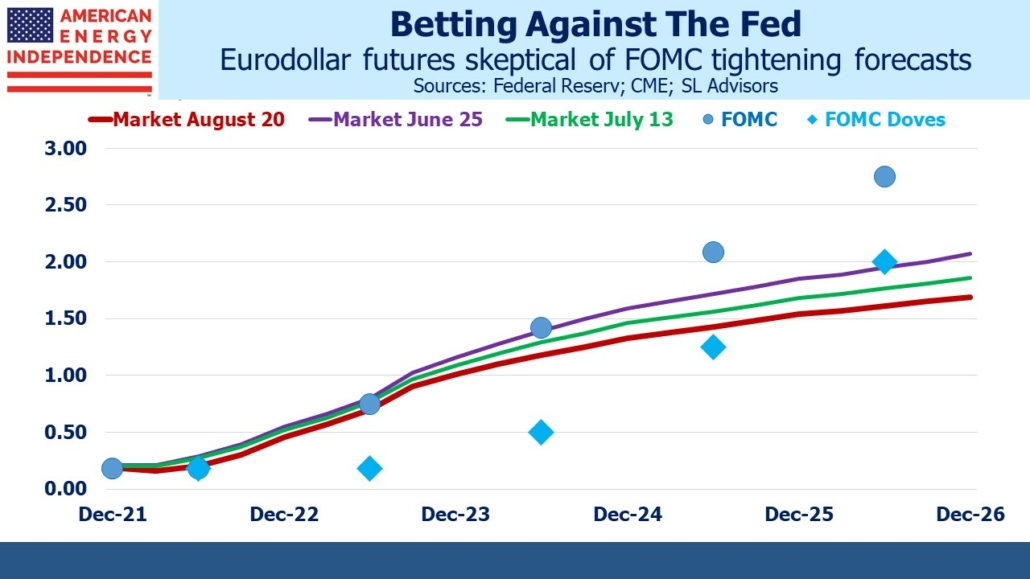Memories of the 2013 “Taper Tantrum” loom over today’s FOMC as they engineer an exit that will hopefully be more elegant than our current one from Afghanistan. Both were well overdue, although there is no doubt the military withdrawal was handled disastrously. Can the Fed do better?
Unlike the Afghan army, the bond market has reacted well to the approaching loss of US government support. Treasury yields even dropped modestly on the week, with the ten-year still around 1.25%, 0.50% below its high in late March.
Real yields have stayed below –1.0%, with implied ten-year inflation (nominal yields less TIPs) of 2.3%. Since the Fed’s bond buying will be over within 6-9 months, today’s yields must reflect close to an equilibrium level for a bond market operating without the crutch of partial debt monetization.
Persistently low long-term interest rates remains one of the most important drivers of valuations. Japan holds $1.3TN in US treasury securities, and China over $1TN. These and other holders are clearly not seeking generous returns. Moreover, the specter of foreign investors dumping bonds and causing a recession has gone. Our second stint of Quantitative Easing (QE) shows that the Fed is a fully capable buyer of last resort. China’s position would sit comfortable alongside the other $8TN on the Fed’s balance sheet. Whatever risk premium bond yields once offered against such a possibility has evaporated.
The bond market’s positive response to tapering is more accurately a reflection of concern over the Delta virus. Cyclical stocks have been under pressure since mid-June, and on Thursday the S&P Energy ETF (XLE) dipped below the 200-day moving average. There are signs that Covid is flattering the bond market’s apparent equanimity over tapering. Nonetheless, the Fed stepping back when there’s clearly ample demand for bonds represents a more elegant exit than waiting until yields had risen to, say, 2%.
The eurodollar yield curve has flattened over the past couple of months as bond yields have drifted lower. Market interest rate forecasts are now solidly below those of the FOMC. Five years out, even the most dovish of the “blue dots” that indicate individual FOMC members’ rate forecasts is almost 0.40% above the market. Although bond investors have pushed yields lower in response to rising hospitalizations from the Delta virus, it’s unlikely FOMC members’ rate forecasts have altered much two to five years out. And the market is still forecasting around one tightening per year from 2023, about half the pace of FOMC members.
Given their explicitly reactive posture, it’s quite likely that the FOMC will be slow to normalize rates. Chair Powell never misses an opportunity to remind us that achieving full employment, which means an unemployment rate at least as low as the January 2020 pre-Covid level of 3.8%, is their objective. It’s likely that the FOMC will rely on emerging wage inflation as confirmation we’ve reached full employment. So they’ll be playing catch-up, which is why the current flatness of the eurodollar curve seems incorrect. Put another way, with the market priced for two tightenings during 2024-25, we think three is more likely than one, and four a decent possibility.
Interest rate futures reflect a slow pace of easing at odds with FOMC forecasts and past history. Given that a philosophy of unlimited spending now drives fiscal policy (see Modern Monetary Theory Goes Mainstream), if the lethargic pace of tightenings turns out to be accurate, there wil be ever greater calls for additional fiscal stimulus to boost economic growth.
It began with the Greenspan put, and successive Fed chairs have been awarded the same moniker. Add to that the Biden put. At the first sign of economic weakness the call will go out for more spending, which remains virtually costless. With debt funded at negative real rates, it almost seems irresponsible to not take advantage of the opportunity.
In 2008 Ben Bernanke revealed the limitless balance sheet capacity of the Federal Reserve, which has moved from $2TN to $8TN since then with no discernible disadvantage to the US economy. Covid-induced fiscal stimulus ushered in Modern Monetary Theory (MMT) as mainstream policy, exploiting a country’s unlimited ability to borrow in its own currency.
Now that Congress has discovered the Magic Money Tree (i.e. MMT), the conditions that justify super-stimulus will become steadily relaxed, just as the use of QE will transition from an extraordinary measure to business as usual.
It’s against that context that the forecasts embedded in the interest rate futures market must be judged.
We are invested in all the components of the American Energy Independence Index via the ETF that seeks to track its performance.
The post Futures Still Disbelieving The Fed appeared first on SL-Advisors.


